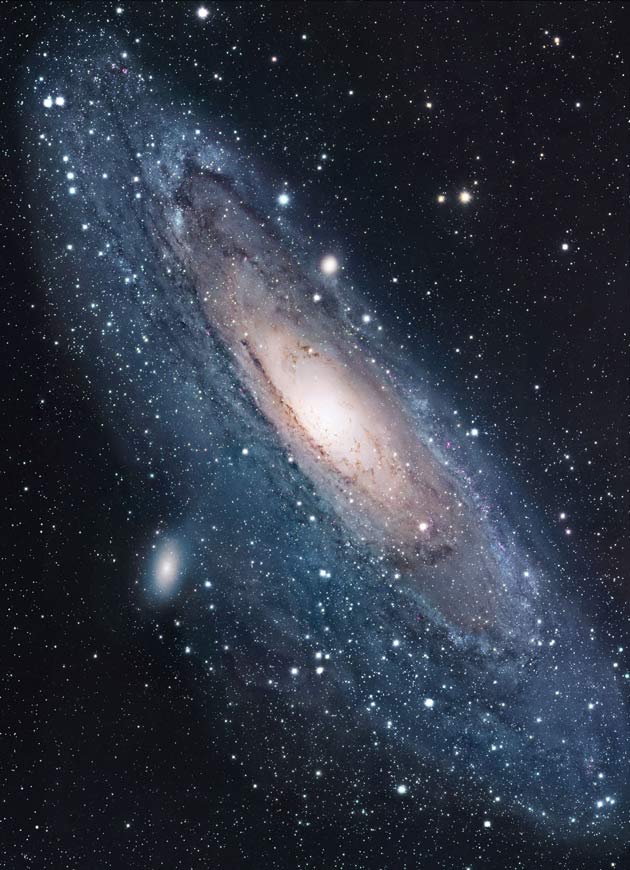Mysterious Stars Surround Andromeda's Black Hole

Stars race around a black hole at the center of the Andromeda galaxy so fast that they could go the distance from Earth to the Moon in six minutes.
The finding, announced today, solves a mystery over the source of strange blue light coming from Andromeda's center. But it generates a new puzzle: The stars' phenomenal orbital velocity suggests they should never have formed in the first place.
Astronomers first spotted the blue light near Andromeda's core in 1995. Three years later, another group determined that the light emanated from a cluster of hot, young stars. Nobody knew how many were involved.
New data from the Hubble Space Telescope reveal more than 400 blue stars that formed in a burst of activity roughly 200 million years ago, astronomers said.
The stars are packed into a disk that is just 1 light-year across.
That's amazingly compact by cosmic standards. A light-year is the distance light travels in a year, about 6 trillion miles (10 trillion kilometers). The nearest star to our Sun is about 4.3 light-years away.
Unlikely setup
Get the Space.com Newsletter
Breaking space news, the latest updates on rocket launches, skywatching events and more!
"The blue stars in the disk are so short-lived that it is unlikely in the long 12-billion-year history of Andromeda that such a short-lived disk would appear now," said Tod Lauer of the National Optical Astronomy Observatory in Tucson, Arizona. "We think that the mechanism that formed this disk of stars probably formed other stellar disks in the past and will trigger them again in the future. We still don't know, however, how such a disk could form in the first place. It still remains an enigma."
To determine the velocity of the stars, Hubble was used to calculate the compression and stretching of the light waves coming from the stars. This Doppler technique is based on the same phenomenon that changes the sound of an ambulance siren that's moving first toward you and then away.
The stars are traveling at 2.2 million mph (1,000 kilometers per second). They could circle the Earth in 40 seconds. The fastest among them orbit the center of Andromeda in 100 years.
Control freak
The stellar speed is controlled by the galaxy's central black hole. Such frenetic activity was thought to prevent star formation. Stars form when a knot of gas and dust collapses under its own gravity.
"Gas that might form stars must spin around the black hole so quickly -- and so much more quickly near the black hole than farther out -- that star formation looks almost impossible. But the stars are there," said team member Ralf Bender of the Max Planck Institute for Extraterrestrial Physics in Garching, Germany.
The observations may provide clues to the activities in the cores of more distant galaxies that cannot be observed so well. At about 2.5 million light-years away, Andromeda is the nearest large galaxy to our own Milky Way.
Lauer led an international team of researchers. The results are published today in the Astrophysical Journal.
Common activity?
The new observations also provide clinching evidence that Andromeda's central dark object is a black hole and not something else. It packs a mass of 140 million suns, the new study finds.
Ultimately, the strange goings-on in Andromeda may turn out to be commonplace.
"The dynamics within the core of this neighboring galaxy may be more common than we think," Lauer said. "Our own Milky Way apparently has even younger stars close to its own black hole. It seems unlikely that only the closest two big galaxies should have this odd activity. So this behavior may not be the exception but the rule. And we have found other galaxies that have a double nucleus."
Hubble is a cooperative effort between NASA and the European Space Agency.
- Survival Tips for Black Hole Travelers
- When Andromeda Collides with Our Milky Way
- Stars Orbiting Close to Milky Way's Black Hole
- New Twists on the Milky Way's Big Black Hole
- Health Checkup: Engineers Work to Stall Hubble's Death
Join our Space Forums to keep talking space on the latest missions, night sky and more! And if you have a news tip, correction or comment, let us know at: community@space.com.

Rob has been producing internet content since the mid-1990s. He was a writer, editor and Director of Site Operations at Space.com starting in 1999. He served as Managing Editor of LiveScience since its launch in 2004. He then oversaw news operations for the Space.com's then-parent company TechMediaNetwork's growing suite of technology, science and business news sites. Prior to joining the company, Rob was an editor at The Star-Ledger in New Jersey. He has a journalism degree from Humboldt State University in California, is an author and also writes for Medium.









